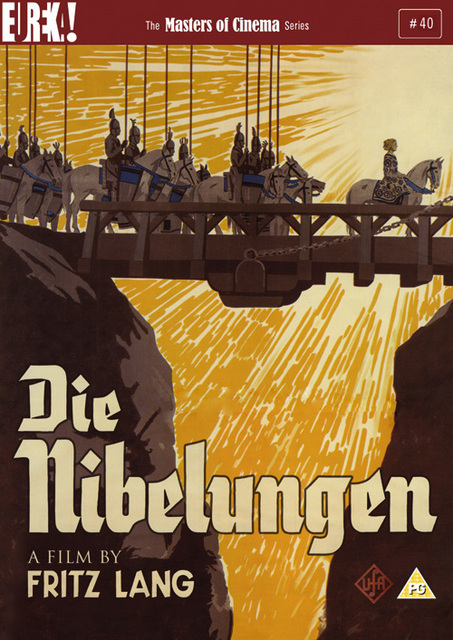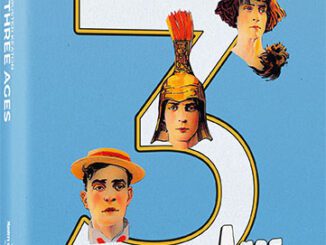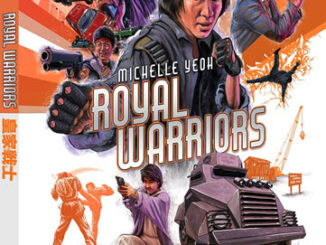The Indian Tomb (1921)
Directed by: Joe May
Written by: Fritz Lang, Thea Von Harbou
Starring: Conrad Veidt, Erma Moreno, Mia May, Olaf Fønss
AKA DAS INDISCHE GRABMAL
GERMANY
AVAILABLE ON BLU-RAY: 14th February, from EUREKA ENTERTAINMENT
RUNNING TIME: THE MISSION OF THE YOGHI 120 mins, THE TIGER OF ESCHNAPAR 90 mins
REVIEWED BY: Dr Lenera

Ayan, the spoiled maharajah of Bengal, awakens the yogi Ramigani from his holy sleep. He gets him to fetch the English architect Herbert Rowland so he can design and construct the most beautiful tomb in the world for his wife, though Herbert has to leave immediately without telling his fiancee Irene Amundsen. While she follows them despite the efforts of Ramigani, Herbert discovers that Ayan’s wife, Savitri, is actually not dead but is imprisoned in the palace. She was caught having an affair with MacAllen, an English army officer, and her husband isn’t best pleased about that. Herbert begins to have second feelings about his task but Ayan is pretty insistent. Then Irene shows up, upsetting things even further….

When our boss Bat contacted me to tell me that she’d been sent something called The Indian Tomb, I automatically thought that it would be Fritz Lang’s 1959/1960 two parter of the same title. Lang is always worth watching, with even his lesser works being full of interest and those familiar themes that he was fascinated by, but it turned out to be a silent version of the same story where Lang was one of the screenwriters. The director is Joe May, and I’ll be honest and admit that I hadn’t even heard of him before now, even though I like German Expressionistic cinema of the period so am familiar with some of the country’s filmmakers who were around then. The Indian Tomb – and I’m treating both parts as one film because that’s what they are – has shades of that genre, though it’s generally pulp entertainment of a less stylisted variety. Popular entertainment of the early 2o0th century seemed to be fascinated with the East, though of course it was often depicted in a very cliched and stereotypical fashion which would rub many modern viewers up the wrong way even if I don’t tend to be bothered about such things. Actually that’s not entirely true – I found the The Mask Of Fu Manchu to be distinctly iffy in places when I saw it for the first time a year or so ago even to my not particularly Woke eyes, so I do have some sensitivity. One thing I don’t understand is how some have a problem with people playing others of different races. This is a discussion for another time, but The Indian Tomb is typical of its time in not featuring a single Indian actor [though one of the palace servants is black, oddly enough], even though no expense seems to have been spared in putting every Indian-themed thing its creators could think of up on the screen.
Its hapless Germans stumble through this exotic world, dwarfed by its massive palaces and temples. Everything seems to be thrown into this tale of obsession, deception and revenge, and yet it’s something that I think would be rather hard going unless you really are pretty experienced in silent cinema. The plot thought up by Thea von Harbou in her novel seems very stretched out on film in what is three and a half hours long. It would make a really solid and even exciting two hour piece, perhaps even a two and a half hour piece, but it sometimes feels like every thing Harbor and Lang can think of to slow the story down, they use. Of course there’s nothing inherently wrong with a movie that takes its time, but this sort of adventure stuff works best when it’s fast paced, even allowing for the fact that there’s a fair bit of that Germanic gloom if not quite actual expressionism. Yet there are definitely some very memorable scenes and images that may stick with you, and one just has to admire the scale of the thing, with no models or rear projection; it’s all sets and often huge ones too. It also has another memorable role for an actor who’s become one of my favourites from the time, Conrad Veidt. He’s a villain but a villain tortured with pain and twisted love, a villain who you pity as much as fear. The last role I saw him in was as Paul Orlac, the guy with the hands of a murderer in The Hands Of Orlac, also out on Blu-ray from Eureka Entertainment – not that I want to sound like I’m promoting them but they are one of our favourite labels. There, his performing was as over the top [yet very effective in its own way] as you can get. Here, he’s quite restrained, often using his great eyes to do much of the emoting. It’s no wonder really that, unlike so many silent film stars, he was able to go on to have a good career in talkies before his far too early death at 50 from a heart attack while playing golf.
The two parts are divided into several chapters, with two extra chapters in the shorter second part which is a little odd. Anyway, after text telling us about Yogis and their mission to remove themselves from all earthly desires so they can reach nirvana, we get into the prologue. Some men are digging up a body, shoveling the earth and shoving the branches off a very simple grave containing our yogi, Ramigani. I’m not quite sure whether he’s supposed to be in very deep sleep or actually dead, though either way he’s oddly sat forward with his head in his hands. He’s put on a stretcher and taken to “The Temple of the Multi-Armed Goddess”[that’ll be Kali then?] where a ceremony brings him to life. You’ll immediately see what I mean about the pacing, though at least here it adds to the sense of a ritual. Ramigani awakes and, seeing Ayan, says to him, “You brought me back to life, the holy laws inescapably force me to obey your deepest wishes. Command”! The reply he gets is probably this film’s only example of brevity,”You are omniscent, Ramigani. You know my plan. Go to Europe”. He then walks off a ledge and vanishes into thin air, ending what is certainly an effective beginning. Our somewhat mature architect hero Herbert is first seen imagining the Taj Mahal, a building that he thinks would have been better if he’d built it. Ramagani materialises in a chair and gives him a letter from Ayan asking him to build a tomb for a woman he loved, also telling Herbert he must leave within an hour. Ramigani’s head is eerily superimposed over some traveling shots and then a wheel falls off Irene’s car. Herbert writes a letter to Irene that she may follow, but, in a rather creepy moment, an invisible hand takes the letter. However, the butler tells her the word Ramigani told his driver, and it turns out to mean “harbour.”Soon she’s also heading for India.

Only an hour has passed for what seems like very little plot indeed, then, as Herbert arrives at his destination, we’re treated to many lingering shots of the huge architecture and a river. Ramigani tells Ayan that he foresees disaster, but still proceeds with his still rather vague plan. Ayan refuses to release Herbert who he tells him that his wife is not dead and that she betrayed him. The man she betrayed him with, MacAllen, is in danger from Ayan’s men who have been sent to kidnap him. Savitri’s servant Mirrjha tells her that MacAllen is in danger. Savitri tells Mirrjha to ask Herbert and Irene to help him, but then Irene shows up. There’s a rather lovely yet moving moment when Ayan sees how much Irene loves Herbert and it makes him realise how alone he is. Veidt’s face, especially his hugely expressive eyes, goes from arrogance to surprise to sadness. Ayan doesn’t allow Irene to see Herbert but lets her stay in the palace, while her love and devotion for her fiancee impresses him so much that he wants to win it for himself. There’s some rather jarring intercutting near the end of the first part between Irene having a walk in a bird-filled garden and MacAllen fighting off Ayan’s men with a rifle. The second portion continues as before though speeds up in the final section as the stakes get higher and there’s an action climax finishing with a rope bridge sequence that has certain similarities with the one in Indiana Jones And The Temple Of Doom, and not just because it features a rope bridge. Two people who we think will die don’t, while the script also isn’t afraid of killing off folk that we like, though after some thought it occurred to me that, actually, the rigid morality of the period would have required this in two examples.
Magic plays a part here and there, but the character of Ramigani becomes curiously less and less prominent and doesn’t feature in the climactic events at all. We understand much earlier that he doesn’t like being used for nefarious purposes and is worried about the future, so this is probably why he therefore walks away, but Ramagani remains very vague – which some might say is appropriate of course. The fantasy aspect therefore gradually diminishes also after a quite amazing and startling shot where an extraordinarily dressed Ayan is in a window and steps out of it. The effect is incredibly good and must have truly astonished viewers at the time. A person dancing who’s bitten by a snake is a good set piece in terms of build up, though the climax of the scene doesn’t quite have the impact it should. Most viewers will probably remember most vividly Irene in a dungeon full of people on various torture devices only they seem to be torturing themselves as penitence, and an attack by lepers; ignoring the crassness of lepers being depicted as figures of fear, the scene is extremely well staged and the makeup is pretty convincing. Then there’s also a pit of tigers to which you know somebody’s going to be fed. Elephants are rode up a steep hill and one of them collapses but is somehow goaded into getting up and carrying on, an unpleasant sight to us animal lovers but neither the makers nor audiences would have cared much about that back then. One can certainly cringe when the news that a “white Sahib is in danger” is considered to be of seemingly more importance than a native in peril, but Ayan’s anger can easily be interpreted as being against British colonialism itself. I wonder if he’d be so angry and tormented if the ‘other man’ was Indian.
Bernhard Goetzke makes a considerable impression as Ramigani; he moves his body in a very stiff way, which would probably be the case if he’d been dead or asleep for many years, but has a very mysterious presence. He reminds me of Boris Karloff as Imhotep in the first version of The Mummy. The women, who include May’s swife Mia, fare slightly less well but nobody disgraces themselves. May’s direction emphasises the visual aspect, especially the buildings with their lush, meticulously decorated interiors, though we don’t get as much of the moody lighting or borderline surreal elements you might expect. The Indian Tomb was definitely has its moments and its plot still manages to be reasonably involving despite the way that it’s hugely elongated. I wouldn’t at all call it a neglected classic though.
Rating: 









SPECIAL FEATURES
Disc 1 – The Mission of the Yoghi
Disc 2 – The Tiger of Eschnapur
Both parts presented in 1080p HD, across two Blu-ray discs from 2K restorations undertaken by the Murnau foundation (FWMS)
Introductory text on both discs tells us that the print was sourced from several different versions, primarily because what had been the main version for a long time was heavily cut. Indeed one can tell what was removed because the picture becomes scratchy and a bit softer, though I’ve seen far worse from the period. The majority of the flick looks really good for its age, and you can truly luxuriate in the lavish settings. Its tinted in green, blue, pink and black and white as appropriate.
Musical Score [2018] by Irena and Vojtewch Havel
The music score isn’t too successful. Sections of piano riffs, violin patterns and a very loud organ note are repeated over and over again and are often backed up by extremely distracting percussion and even sound effects. The music often doesn’t seem to correspond with what’s happening on screen; for example we sometimes get dramatic exciting sonorities that are replaced before a suitably dramatic exciting moment actually happens.
Optional English subtitles
Turbans Over Woltersdorf – Brand New video essay by David Cairns & Fiona Watson[46 mins]
Rather longer than the usual Cairns and Watson piece, this looks at the careers of the three main creators; May, Lang and von Harbou. Cairns narrates the majority, though Watson does a section and we also not only have footage from Joe and Mia May’s daughter talking, but also from after a showing of the film where a lady says how it’s quite respectful of Indians given the time it was made in, and why. We learn that changes made from the novel included blind horses with opals in their eyes becoming the elephants; it sounds like the book was greatly toned down. Some of the most interesting information is about the three man folk involved. Veidt was big into the occult but after a while sealed all his books in a case because he felt they were becoming too strong an influence on him. May met Lang in a hospital while both were suffering World War 1 injuries. Lang’s wife killed herself when she found out about his affair with Von Harbou. It’s not all this kind of thing though; a late section consists of portions from a programme where the location where May built his Indian world is revisited; it’s really poignant seeing just a few columns standing there, all that remains. A very fine piece overall.
A collector’s booklet featuring new writing on the film by Philip Kemp
This grandiose melding of adventure and melodrama is recommended for silent movie buffs, perhaps not for others or new starters!





Since watching a live presentation of Napoleon in London, many years ago, with an orchestra conducted by Carl Davis. I have begun to collect some of these wonderful films from Lang. Murnau, Dreyer, but am saddened by the wasted opportunities for an appropriate score. metropolis. and Die Nibelungen. Gottfried Huppertz. Timothy Brock, Faust. So why a dire monotonous score for so many of these films which deserve better. I am steeling myself for The Indian Tomb accompanied by a rambling series of tunes which have nothing to do with the film. Therefore are a needless and inept distraction
Jonathan. England (UK)